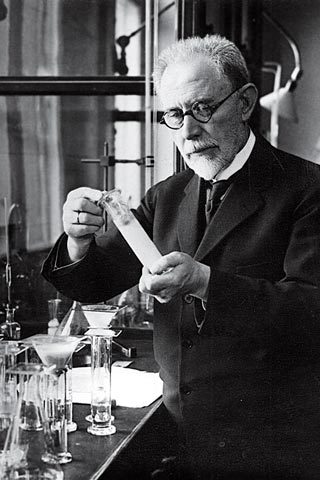
pH Testing and Citizen Science
[Photo: Søren Peder Lauritz Sørensen- Chemist who developed the pH Scale in 1909. Source: Carlsberg Lab Archives]
pH Testing & Citizen Science
Testing for acidity and basicity has undergone significant development since the emergence of litmus paper, first utilized in the early 1300’s by Arnaldus de Villa Nova, who initially deployed blue dyes extracted from lichens in the Netherlands to ascertain the acidity of aqueous solutions. The first use of the term “pH” in 1909 is credited to a research chemist at the Carlsberg Laboratory in Copenhagen, Denmark, Søren Peder Lauritz Sørensen. He developed a scale, based upon the “puissance” or power of Hydrogen to determine the acidity, alkalinity or basicity of a liquid substance.His scale runs from 0 (most acidic) to 14 (most alkaline).
In John Buie’s article in Lab Manager, October 07, 2010, “Evolution of the pH Meter: Tracing the origins of the pH meter and looking ahead to future advances,” he traces the evolution of pH meters from the pioneering work of Cremer, Haber and Klemensiewicz in the early 1900’s, through advancements by Beckman in the 1930’s, as well as Kuntze & Cannon in the 1940’s. The Buie chronology continues with miniaturization of pH meters, emerging in 1948, with NEOTEK PONSEL’s introduction of the first handheld pH meter, with continuing innovations by companies such as Jenco Electronics, WTW, Hanna, Schott, Denver Instruments, Mettler Toledo, Sartorius Mechatronics, Metrohm and Hach Lange.
Obviously, ingestion or mere contact with liquids that are highly acidic (i.e. with a low pH), such as sulfuric acid, hydrochloric acid, battery acid, etc. can be fatal or extremely debilitating. Similarly, ingestion or more contact with liquids that are highly alkaline (i.e. very high pH), such as lye (sodium hydroxide or potassium hydroxide), liquid drain cleaner, bleach, etc. can also be fatal or extremely debilitating. Testing for appropriate pH levels is essential in determining potability of water, suitability of water for swimming, or serving as an indicator of potential water contamination from industrial effluent.
The quest for relatively low cost methods for measuring pH yielded a wide variety of instruments and testing kits, under $130.
Topeakmart 2 Packs PH 1-14 Test Paper Litmus Strips Tester, 80pcs Per Pack $4.29
Hydrion 93 S/R Insta-Check pH Test Paper Dispenser - Level 0-13 $5.49
Newdy Digital PH Meter Tester for Water Quality, Food, Aquarium, Pool & Hydroponics,0.01 / High Accuracy +/- 0.05 and 0.00-14.00 Measurement Range, Large LCD Display Battery Included -$13.99
Milwaukee pH600 Economical Pocket pH Meter - $19.95 ±0.1 pH accuracy and a range of 0.0 to 14.0 pH.
Gravity Analog pH Meter Kit (DIY) Product Code : RB-Dfr-483 by DFRobot - Measuring Range: 0-14PH Accuracy: ± 0.1pH (25°C); Price: $29.50
Whatman 10360005 Strips, pH range 0 to 14, pH indicators and test papers, 200 per pack $32.14
Hanna Instruments 716435 Checker pH Tester (HI 98103) $37.70 Fast and accurate readings from 0.00 to 14.00 ph. with a resolution of 0.01 ph
General Tools PH501 Pocket pH Meter Kit - $56.95 RANGE0 to 14 pH Units
ACCURACY±0.2 pH Units
Pocket Pro+ pH Tester with Replaceable Sensor - Hach Accuracy: ± 0.02 pH; Range: 0.00 to 14.00 pH; Resolution: 0.01 pH; Product #: 9532000; Price: $128.00
In addition to the commercial and DIY pH meters, simple litmus paper testing for pH has survived since its introduction in 1300 by Arnaldus de Villa Nova. Several companies continue to produce litmus paper strip kits for pH testing, ranging from Cole-Palmer kits at $4.15, Grainger Industries at $4.95 to $99.50.
Examples of citizen science projects that have utilized water quality testing devices, inter alia include the following:
CITIZEN SCIENCE PROJECTS SUPPORTED BY THE U.S. ENVIRONMENTAL PROTECTION AGENCY (EPA) https://www.epa.gov/citizen-science/citizen-science-projects-supported-epa
CITIZEN SCIENCE PROJECTS FUNDED BY THE NATIONAL INSTITUTE FOR ENVIRONMENTAL HEALTH SCIENCES (NIEHS): https://www.niehs.nih.gov/research/supported/translational/peph/webinars/citizen_science/index.cfm
CITIZEN SCIENCE PROJECTS FEATURED BY THE NATIONAL GEOGRAPHIC SOCIETY: https://www.nationalgeographic.org/idea/citizen-science-projects/
CITIZEN MONITORING & TRAINING: WATER RESEARCH CENTER:
http://www.water-research.net/index.php/citizen-monitoring-and-training
WORLD WATER MONITORING CHALLENGE - SCIENTIFIC AMERICAN: https://www.scientificamerican.com/citizen-science/world-water-monitoring-challenge/
CITIZEN SCIENCE & WATER MONITORING- PLOS.ORG http://blogs.plos.org/citizensci/2014/09/17/citizen-science-water-monitoring-healthy-water-near-2/
SCIENCE TEACHERS’ TOOLBOX: TESTING WATER QUALITY - SHARE IT! SCIENCE NEWS: http://www.shareitscience.com/2015/06/science-teachers-toolbox-testing-water.html "No Ph.D. Needed: 8 Impactful Citizen Science Projects," MASHABLE.COM - http://mashable.com/2014/06/25/citizen-science-projects/#rU7jCpLeTGq8
REFERENCES:
Sørensen, Søren Peter Lauritz (1868-1939)". 100 Distinguished European Chemists. European Association for Chemical and Molecular Sciences. Retrieved 2011-10-14.
John Buie, “Evolution of the pH Meter: Tracing the origins of the pH meter and looking ahead to future advances,” Lab Manager, October 07, 2010.
QUESTIONS:
When is the use of litmus paper insufficient to test for pH?
Have you experienced either positive or negative results using any of the methods or devices listed above?
Have you had results from pH sensors other than those listed above? If so, can you share your experience?
In addition to testing for pH, what other water quality testing have you utilized, such as turbidity, conductivity, dissolved oxygen (DO), etc.? Can you share your experience with these?